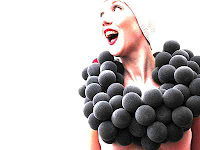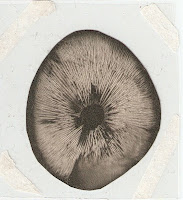So every holiday I go back and think, what else is there to do in the middle of nowhere, but bake things for family and friends! I go a bit crazy otherwise.. :D
(I'm so proud of the cupcakes, they look so professional, hehe!)















 Over Easter 2nd year (argh, nearly 3rd!) Jewellery have been asked to research for the Sustainability project, aiming to make Sustainable jewellery/sculpture in 3rd year. For the end of term we've to finalise our ideas with design boards.
Over Easter 2nd year (argh, nearly 3rd!) Jewellery have been asked to research for the Sustainability project, aiming to make Sustainable jewellery/sculpture in 3rd year. For the end of term we've to finalise our ideas with design boards. After a week full of learning tutorials, some frustration and then thinking *this is so much better than photoshop*...I finished my first ring design using Rhino 3D (presented using photoshop) which I'm pretty pleased with. Based on the project brief 'Hidden' I chose to create silver drops attached to a chain falling off a ring, with a pearl just visible inside one of the drops. The inside of the ring has indented letters which read 'escape' which only the wearer would be aware of.
After a week full of learning tutorials, some frustration and then thinking *this is so much better than photoshop*...I finished my first ring design using Rhino 3D (presented using photoshop) which I'm pretty pleased with. Based on the project brief 'Hidden' I chose to create silver drops attached to a chain falling off a ring, with a pearl just visible inside one of the drops. The inside of the ring has indented letters which read 'escape' which only the wearer would be aware of.
To begin with for assignment 4 I decided to choose the topic I covered last semester which was the Design of train and subway stations. I began with a mind map and asked the question ‘Do you think the design of train stations could/need to be improved?’ in the middle of my map, then branched off with different areas. Such as culture, public service, environment and safety. Questions started to appear as I added more information, and I used the ones I thought would give me the most knowledge and interesting answers for interviewing people. Re-wording questions so as not to give directed or yes/no answers proved difficult but I think I thought about it enough to give me some good results.
I interviewed some acquaintances, friends of friends, and all gave me varied answers for most questions. This may be because three were female, one was male; the male comes from London and uses the subway at least 3 times a week, one female comes from Orkney and only uses the train in Dundee very occasionally, one female is on the train a lot and usually travels alone, and the other female is from Edinburgh but has only ever used the train from Edinburgh to Glasgow with friends/family.
My main aim was to find out how comfortable the interviewees were in train stations, how easy it is to use the service, perhaps how safe they felt on their own. Their opinion on improvement of rail service, does it need improving?
I asked ‘How useful do you find time tables in a train station?’ Generally the feedback was fairly useful and straight forward, can be confusing when in a hurry. The leaflets are easier to read than the sheets on billboards in train stations (which I also agree with) but the boards above the trains which are usually lit up are direct. One female suggested a touch screen board which you could key in information to let you see your own time table for a particular train which is an idea, however maybe not so good if you’re in a rush to get somewhere. Another female also said that the departures and arrivals boards were confusing when in a hurry, perhaps this could be of some improvement?
I did ask about congestion but the main answer was that trains themselves were occasionally packed with too many people, longer trains perhaps? But no issues with general queuing.
‘How energy efficient do you believe trains are? Should there be more information on this?’ “Guessing they would be pretty efficient because you can get more people on a train, and they’re direct. Could have a comparison of using public transport and cars to say why it’s more efficient, why it’s better for you.” All others interviewed said there was little or no information about the efficiency of trains, that there could be more.
Every single person immediately said ‘WH Smith’ when I asked ‘Which shops do they regularly see/notice in stations?’ There are also coffee shops, perhaps a pub and some fast food places. However nobody said they required anything else, a station is a passing place to get from A to B, you don’t need more than a book and a drink to pass some time whilst waiting for your train.
All interviewed said the general atmosphere is that of busy, rushed; female from Orkney also mentioned that it’s smelly, dirty and full of pigeons…not that there is anything so strange about a busy atmosphere, the hustle and bustle of a working day passes through these stations, most said this can be stressful but that it’s also just a normal occurrence, none seemed too bothered about this.
Only the male from London said that he had seen graffiti in stations, he uses the London underground regularly, and said that the images that this creates is one of vandalism.
Young teens with not a lot to do graffiti-ing tags and pictures that don’t mean much. However he mentions graffiti artwork (which I hoped someone would) and said that if it was a piece of wall art he would admire it, that he quite liked it. I asked if say street artists did this more and rid the ‘vandal’ look would the train/subway stations feel a bit safer, perhaps just more interesting? He agreed with this, if somebody like say Banksy or professional street artists were commissioned to landscape our stations then that would be good.
The question I was hoping to get a lot of interesting information from was ‘How do you feel when waiting for a train with friends compared to when you’re by yourself at a platform?’ Nobody gave me an answer that I expected, perhaps if I’d said, at night on an open platform outside, then I would have got some ‘I’d be slightly nervous’ or something similar. Also I did expect the male to say ‘makes no difference at all’ which he did. The general consensus for the three females was they’d be concerned whether they were at the right platform for the train, got the right time, but if they were with friends then they wouldn’t care. Also that it is better to have company, someone to sit with etc.
I had focused on safety and looked at surveys to do with how safe the public felt when in a train station at night last semester so I have to say I was expecting those kinds of answers, perhaps my question was too vague rather than undirected?
I asked if any of the four new of any other countries with ‘good’ subway systems? One female said she had heard that German and Scandinavian countries tended to have good railways, that we could learn from German rail as they are punctual and environmentally friendly. The male interviewee said that England tended to have better rail travel than Scotland, that France, Canada and Moscow had very good rail service. Not one mentioned Japan…which surprised me a little (again, maybe because I wrote about it last semester) but maybe due to it’s famous for its regimental shoving at rush hour? Looking back on it maybe I should have had a question to ask whether they had heard about this…
As a last question I asked what they might think tourists would think of our railway stations. All but one said that it didn’t really matter, that it was our problem to worry about and not their’s if they’re not up to our standard…but surely, if people visit this country even if we don’t care about how good we look exactly, we want them to have a pleasant experience whilst they’re here? One female said “I do believe it’s important, it all comes down to how they see our country. Tourists do use our public transport; there is always a tourist information point.” Which I thought was a good observation, why would there be info points if Tourists didn’t use our transport? I wasn’t so sure myself if many tourists would use train stations, maybe Subways more, but they probably do. Something to look up for me now would possibly be the tourist industry, how often do they use public transport?
I can see that from doing interviews I have gathered a lot of different information from only asking a few question from just four people. All with varied backgrounds and train station experience but I feel like I’ve gained some valid points which I could use as genuine research. If I asked more people would I begin to see patterns and similar answers? Or perhaps if I made my questions more detailed would have I gained more answers that I expected to get the first time round, would I make them more directed? I think if I did it again I would have asked more in-depth questions back from their answers. I can see how using interviews can be useful in gaining research of public opinion; it can be tricky however I think could be made very successful with a lot more practice!



